Potential Environmental Impacts of Peanut Using Water Footprint Assessment: A Case Study in Georgia
Abstract
1. Introduction
2. Materials and Methods
2.1. Defining Goal and Scope (Phase 1)
2.2. Scope (System Boundary)
2.3. Functional Unit
2.4. WFP Accounting/Inventory Phase (Phase 2)
2.4.1. Crop Water Requirement
2.4.2. Blue, Green, and Grey Water Footprint
2.5. Sustainability Assessment/Impact Assessment (Phase 3)
2.5.1. Water Scarcity Impact Assessments (Mid-Point)
2.5.2. Freshwater Ecotoxicity Impact Assessments (Mid-Point)
2.5.3. Effects on Ecosystem Quality (End-Point)
2.6. Statistical Analysis
Selection of Independent Variables
2.7. Data Sets Used
3. Results
3.1. WFP of Peanut Crop from 2007 to 2017
3.2. Blue and Green Water Impacts
3.3. Potential Freshwater Ecotoxicity Impacts: Emissions to Water
3.4. End-Point Impacts
3.5. Sensitivity Analysis
4. Discussion
4.1. Water Consumption of Peanut Crop
4.2. Water Consumption Impacts—Blue and Green Water Scarcity
4.3. Freshwater Ecotoxicity Impacts
4.4. Limitations
5. Conclusions
Supplementary Materials
Author Contributions
Funding
Institutional Review Board Statement
Informed Consent Statement
Data Availability Statement
Conflicts of Interest
Appendix A
| County | Mean (m3/ton) | Standard Deviation (m3/ton) | ||||
|---|---|---|---|---|---|---|
| Green | Blue | Grey | Green | Blue | Grey | |
| Seminole | 371 | 865 | 322 | 71 | 118 | 141 |
| Irwin | 443 | 1100 | 374 | 79 | 221 | 167 |
| Early | 395 | 1004 | 278 | 80 | 224 | 137 |
| Miller | 359 | 867 | 247 | 59 | 133 | 127 |
| Mitchell | 389 | 927 | 249 | 69 | 165 | 139 |
| Decatur | 369 | 854 | 223 | 68 | 129 | 102 |
| Worth | 449 | 1109 | 265 | 71 | 193 | 99 |
| Colquitt | 421 | 987 | 359 | 83 | 185 | 222 |
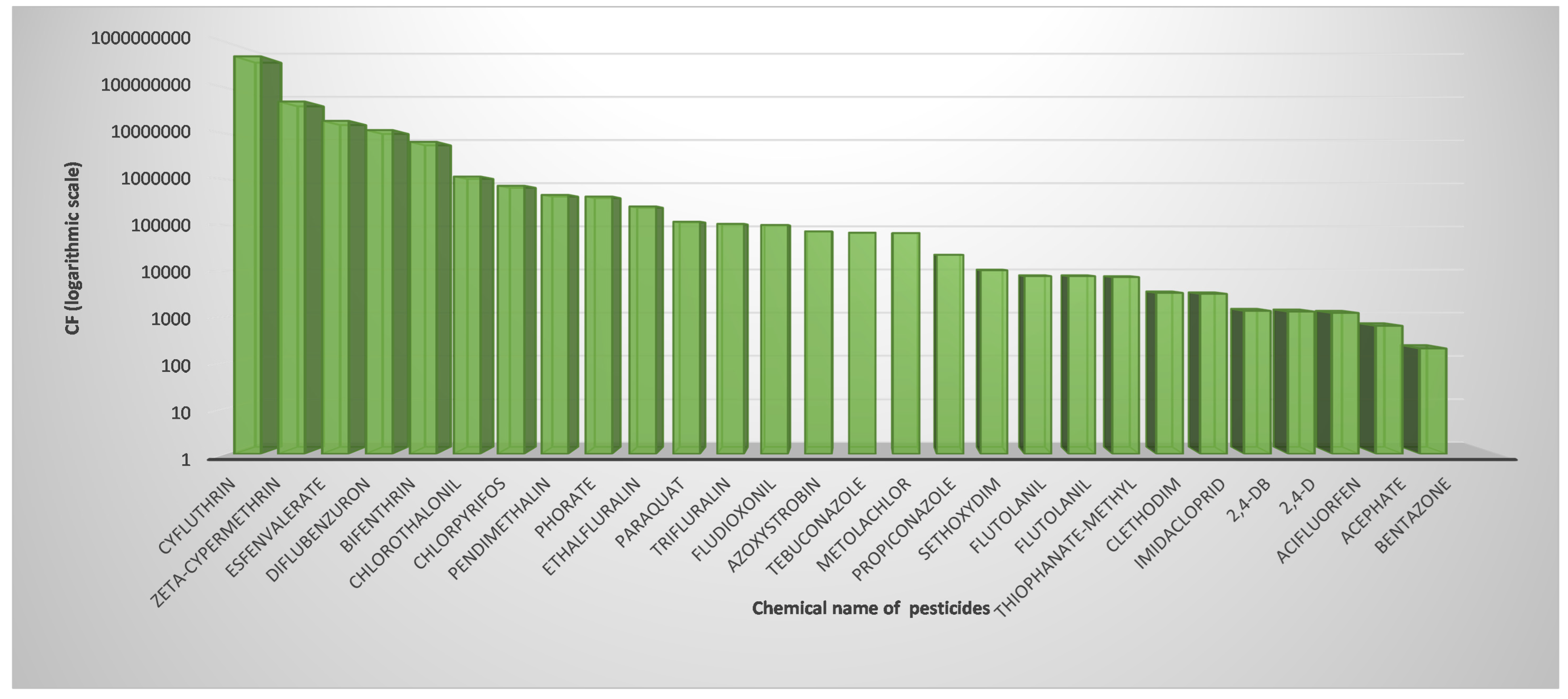
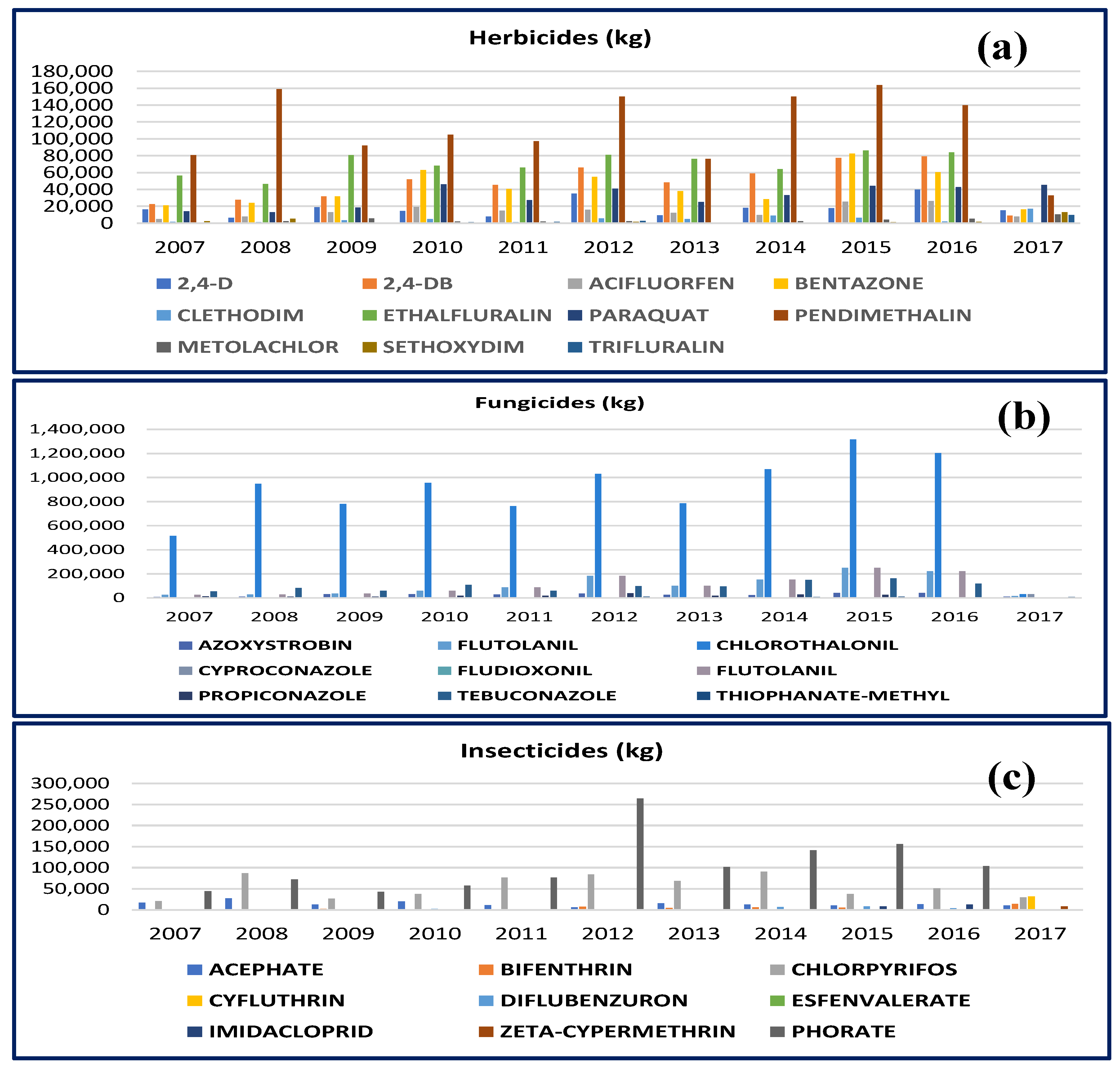
References
- World Economic Forum. Global Risks 2020: An Unsettled World. 2020. Available online: https://www3.weforum.org/docs/WEF_Global_Risk_Report_2020.pdf (accessed on 4 October 2021).
- Vörösmarty, C.J.; McIntyre, P.B.; Gessner, M.O.; Dudgeon, D.; Prusevich, A.; Green, P.; Glidden, S.; Bunn, S.E.; Sullivan, C.A.; Liermann, C.R.; et al. Global threats to human water security and river biodiversity. Nature 2010, 467, 555–561. [Google Scholar] [CrossRef] [PubMed]
- Veettil, A.V.; Mishra, A. Water Security Assessment for the Contiguous United States Using Water Footprint Concepts. Geophys. Res. Lett. 2020, 47, 7. [Google Scholar] [CrossRef]
- AghaKouchak, A.; Cheng, L.; Mazdiyasni, O.; Farahmand, A. Global warming and changes in risk of concurrent climate extremes: Insights from the 2014 California drought. Geophys. Res. Lett. 2014, 41, 8847–8852. [Google Scholar] [CrossRef]
- Stewart, I.T.; Rogers, J.; Graham, A. Water security under severe drought and climate change: Disparate impacts of the recent severe drought on environmental flows and water supplies in Central California. J. Hydrol. X 2020, 7, 100054. [Google Scholar] [CrossRef]
- Cook, E.R.; Woodhouse, C.A.; Eakin, C.M.; Meko, D.M.; Stahle, D.W. Long-Term Aridity Changes in the Western United States. Science 2004, 306, 1015–1018. [Google Scholar] [CrossRef] [PubMed]
- Vories, E.D.; Evett, S.R. Irrigation Research Needs in the USA Mid-South and Southeast, Humid and Sub-Humid Regions. In Proceedings of the 5th National Decennial Irrigation Conference, Phoenix Convention Center, Phoenix, AZ, USA, 5–8 December 2010. [Google Scholar]
- Singh, B.; Singh, U. Peanut as a source of protein for human foods. Plant Foods Hum. Nutr. 1991, 41, 165–177. [Google Scholar] [CrossRef]
- Mccarty, J.A.; Sandefur, H.N.; Matlock, M.; Thoma, G.; Kim, D. Life Cycle Assessment of Greenhouse Gas Emissions Associated with Production and Consumption of Peanut Butter in the U.S. Trans. ASABE 2014, 57, 1741–1750. [Google Scholar] [CrossRef]
- Hoekstra, A.Y. Value of Water; International Institute for Infrastructural Hydraulic and Environmental Engineering: Delft, The Netherlands, 2003; Proceedings 12. [Google Scholar]
- Hoekstra, A.Y.; Chapagain, A.K.; Aldaya, M.M.; Mekonnen, M.M. The Water Footprint Assessment Manual: Setting the Global Standard; Routledge: Abingdon, UK, 2011. [Google Scholar]
- Chapagain, A.K.; Hoekstra, A.Y. Water Footprints of Nations. Available online: https://research.utwente.nl/en/publications/water-footprints-of-nations (accessed on 15 March 2022).
- Chapagain, A.; Hoekstra, A.; Savenije, H.; Gautam, R. The water footprint of cotton consumption: An assessment of the impact of worldwide consumption of cotton products on the water resources in the cotton producing countries. Ecol. Econ. 2006, 60, 186–203. [Google Scholar] [CrossRef]
- Chapagain, A.; Hoekstra, A. The blue, green and grey water footprint of rice from production and consumption perspectives. Ecol. Econ. 2011, 70, 749–758. [Google Scholar] [CrossRef]
- Gerbens-Leenes, W.; Berger, M.; Allan, J. Water Footprint and Life Cycle Assessment: The Complementary Strengths of Analyzing Global Freshwater Appropriation and Resulting Local Impacts. Water 2021, 13, 803. [Google Scholar] [CrossRef]
- Berger, M.; Campos, J.; Carolli, M.; Dantas, I.; Forin, S.; Kosatica, E.; Kramer, A.; Mikosch, N.; Nouri, H.; Schlattmann, A.; et al. Advancing the Water Footprint into an Instrument to Support Achieving the SDGs—Recommendations from the “Water as a Global Resources” Research Initiative (GRoW). Water Resour. Manag. 2021, 35, 1291–1298. [Google Scholar] [CrossRef]
- Chapagain, A.; Hoekstra, A. The water footprint of coffee and tea consumption in the Netherlands. Ecol. Econ. 2007, 64, 109–118. [Google Scholar] [CrossRef]
- Chapagain, A.; Orr, S. An improved water footprint methodology linking global consumption to local water resources: A case of Spanish tomatoes. J. Environ. Manag. 2009, 90, 1219–1228. [Google Scholar] [CrossRef] [PubMed]
- Chiu, Y.; Walseth, B.; Suh, S. Water Embodied in Bioethanol in the United States. Environ. Sci. Technol. 2009, 43, 2688–2692. [Google Scholar] [CrossRef]
- Gerbens-Leenes, W.; Hoekstra, A.Y. The water footprint of sweeteners and bio-ethanol. Environ. Int. 2012, 40, 202–211. [Google Scholar] [CrossRef]
- Fader, M.; Gerten, D.; Thammer, M.; Heinke, J.; Lotze-Campen, H.; Lucht, W.; Cramer, W. Internal and external green-blue agricultural water footprints of nations, and related water and land savings through trade. Hydrol. Earth Syst. Sci. 2011, 15, 1641–1660. [Google Scholar] [CrossRef]
- Gerten, D.; Heinke, J.; Hoff, H.; Biemans, M.; Fader, M.; Waha, K. Global Water Availability and Requirements for Future Food Production. J. Hydrometeorol. 2011, 12, 885–899. Available online: https://journals.ametsoc.org/view/journals/hydr/12/5/2011jhm1328_1.xml?searchresult=1&tab_body=fulltext-display (accessed on 15 March 2022). [CrossRef]
- Jefferies, D.; Muñoz, I.; Hodges, J.; King, V.J.; Aldaya, M.M.; Ercin, A.E.; Milà i Canals, L.; Hoekstra, A.Y. Water Footprint and Life Cycle Assessment as approaches to assess potential impacts of products on water consumption. Key learning points from pilot studies on tea and margarine. J. Clean. Prod. 2012, 33, 155–166. [Google Scholar] [CrossRef]
- Ridoutt, B.G.; Huang, J. Environmental relevance--the key to understanding water footprints. Proc. Natl. Acad. Sci. USA 2012, 109, E1424. [Google Scholar] [CrossRef]
- Pfister, S.; Koehler, A.; Hellweg, S. Assessing the Environmental Impacts of Freshwater Consumption in LCA. Environ. Sci. Technol. 2009, 43, 4098–4104. [Google Scholar] [CrossRef]
- Herath, I.; Green, S.; Horne, D.; Singh, R.; Clothier, B. Quantifying and reducing the water footprint of rain-fed potato production, part I: Measuring the net use of blue and green water. J. Clean. Prod. 2014, 81, 111–119. [Google Scholar] [CrossRef]
- Boulay, A.-M.; Bare, J.; Benini, L.; Berger, M.; Lathuillière, M.J.; Manzardo, A.; Margni, M.; Motoshita, M.; Nunez, M.; Pastor, A.V.; et al. The WULCA consensus characterization model for water scarcity footprints: Assessing impacts of water consumption based on available water remaining (AWARE). Int. J. Life Cycle Assess. 2018, 23, 368–378. [Google Scholar] [CrossRef]
- Canals, L.M.I.; Chenoweth, J.; Chapagain, A.; Orr, S.; Antón, A.; Clift, R. Assessing freshwater use impacts in LCA: Part I—inventory modelling and characterisation factors for the main impact pathways. Int. J. Life Cycle Assess. 2008, 14, 28–42. [Google Scholar] [CrossRef]
- Zhang, Y.; Huang, K.; Yu, Y.; Yang, B. Mapping of water footprint research: A bibliometric analysis during 2006–2015. J. Clean. Prod. 2017, 149, 70–79. [Google Scholar] [CrossRef]
- ISO/TC 207/SC 5, “ISO 14046:2014.”. ISO: Geneva, Switzerland, 2014. Available online: https://www.iso.org/cms/render/live/en/sites/isoorg/contents/data/standard/04/32/43263.html (accessed on 15 March 2022).
- Greer, K.; Martins, C.; White, M.; Pittelkow, C. Assessment of high-input soybean management in the US Midwest: Balancing crop production with environmental performance. Agric. Ecosyst. Environ. 2020, 292, 106811. [Google Scholar] [CrossRef]
- Bhattacharyya, N.; Goodell, A.; Rogers, S.; Demond, A. Environmental impacts of wheat-based vodka production using life cycle assessment. J. Clean. Prod. 2019, 231, 642–648. [Google Scholar] [CrossRef]
- Yang, Y.; Suh, S. Land cover change from cotton to corn in the USA relieves freshwater ecotoxicity impact but may aggravate other regional environmental impacts. Int. J. Life Cycle Assess. 2014, 20, 196–203. [Google Scholar] [CrossRef]
- Nordborg, M.; Cederberg, C.; Berndes, G. Modeling Potential Freshwater Ecotoxicity Impacts Due to Pesticide Use in Biofuel Feedstock Production: The Cases of Maize, Rapeseed, Salix, Soybean, Sugar Cane, and Wheat. Environ. Sci. Technol. 2014, 48, 11379–11388. [Google Scholar] [CrossRef]
- Wallander, S.; Claassen, R.; Nickerson, C. The Ethanol Decade: An Expansion of U.S. Corn Production, 2000-09; Social Science Research Network: Rochester, NY, USA, 2011; SSRN Scholarly Paper ID 2131399. [Google Scholar] [CrossRef]
- Vanham, D.; Leip, A.; Galli, A.; Kastner, T.; Bruckner, M.; Uwizeye, A.; van Dijk, K.; Ercin, E.; Dalin, C.; Brandão, M.; et al. Environmental footprint family to address local to planetary sustainability and deliver on the SDGs. Sci. Total Environ. 2019, 693, 133642. [Google Scholar] [CrossRef]
- Beck, H.E.; Zimmermann, N.E.; McVicar, T.R.; Vergopolan, N.; Berg, A.; Wood, E.F. Present and future Köppen-Geiger climate classification maps at 1-km resolution. Sci. Data 2018, 5, 180214. [Google Scholar] [CrossRef]
- Kottek, M.; Grieser, J.; Beck, C.; Rudolf, B.; Rubel, F. World map of the Köppen-Geiger climate classification updated. Meteorol. Z. 2006, 15, 259–263. [Google Scholar] [CrossRef]
- State Average Data—SERCC. Available online: https://sercc.com/state-climate-data/ (accessed on 4 October 2021).
- Forin, S.; Mikosch, N.; Berger, M.; Finkbeiner, M. Organizational water footprint: A methodological guidance. Int. J. Life Cycle Assess. 2019, 25, 403–422. [Google Scholar] [CrossRef]
- Pacetti, T.; Lombardi, L.; Federici, G. Water–energy Nexus: A case of biogas production from energy crops evaluated by Water Footprint and Life Cycle Assessment (LCA) methods. J. Clean. Prod. 2015, 101, 278–291. [Google Scholar] [CrossRef]
- Qin, L.; Jin, Y.; Duan, P.; He, H. Field-based experimental water footprint study of sunflower growth in a semi-arid region of China. J. Sci. Food Agric. 2016, 96, 3266–3273. [Google Scholar] [CrossRef] [PubMed]
- Allen, R.G.; Food and Agriculture Organization of the United Nations (Eds.) Crop Evapotranspiration: Guidelines for Computing Crop Water Requirements; Food and Agriculture Organization of the United Nations: Rome, Italy, 1998. [Google Scholar]
- Shuttleworth, W.J. Evaporation. Handbook of Hydrology; Maidment, D., Ed.; McGraw-Hill: New York, NY, USA, 1992. [Google Scholar]
- Smith, M.; Allen, R.; Monteith, J.L.; Perrier, A.; Segeren, A. Expert Consultation on Revision of FAO Methodologies for Crop Water Requirements; Food and Agricultural Organization (FAO): Rome, Italy, 1992. [Google Scholar]
- Gheewala, S.H.; Silalertruksa, T.; Nilsalab, P.; Mungkung, R.; Perret, S.R.; Chaiyawannakarn, N. Water Footprint and Impact of Water Consumption for Food, Feed, Fuel Crops Production in Thailand. Water 2014, 6, 1698–1718. [Google Scholar] [CrossRef]
- Boulay, A.-M.; Lenoir, L. Sub-national regionalisation of the AWARE indicator for water scarcity footprint calculations. Ecol. Indic. 2020, 111, 106017. [Google Scholar] [CrossRef]
- Boulay, A.-M.; Lenoir, L.; Manzardo, A. Bridging the Data Gap in the Water Scarcity Footprint by Using Crop-Specific AWARE Factors. Water 2019, 11, 2634. [Google Scholar] [CrossRef]
- Xu, H.; Wu, M. A First Estimation of County-Based Green Water Availability and Its Implications for Agriculture and Bioenergy Production in the United States. Water 2018, 10, 148. [Google Scholar] [CrossRef]
- Darré, E.; Cadenazzi, M.; Mazzilli, S.R.; Rosas, J.F.; Picasso, V.D. Environmental impacts on water resources from summer crops in rainfed and irrigated systems. J. Environ. Manag. 2019, 232, 514–522. [Google Scholar] [CrossRef]
- Rosenbaum, R.K.; Margni, M.; Jolliet, O. A flexible matrix algebra framework for the multimedia multipathway modeling of emission to impacts. Environ. Int. 2007, 33, 624–634. [Google Scholar] [CrossRef]
- Bare, J.C. Development of impact assessment methodologies for environmental sustainability. Clean Technol. Environ. Policy 2014, 16, 681–690. [Google Scholar] [CrossRef]
- Nemani, R.R.; Keeling, C.D.; Hashimoto, H.; Jolly, W.M.; Piper, S.C.; Tucker, C.J.; Myneni, R.B.; Running, S.W. Climate-Driven Increases in Global Terrestrial Net Primary Production from 1982 to 1999. Science 2003, 300, 1560–1563. [Google Scholar] [CrossRef] [PubMed]
- Jolliet, O.; Margni, M.; Charles, R.; Humbert, S.; Payet, J.; Rebitzer, G.; Rosenbaum, R. IMPACT 2002+: A new life cycle impact assessment methodology. Int. J. Life Cycle Assess. 2003, 8, 324–330. [Google Scholar] [CrossRef]
- Berthoud, A.; Maupu, P.; Huet, C.; Poupart, A. Assessing freshwater ecotoxicity of agricultural products in life cycle assessment (LCA): A case study of wheat using French agricultural practices databases and USEtox model. Int. J. Life Cycle Assess. 2011, 16, 841–847. [Google Scholar] [CrossRef]
- Tao, M.; Adler, P.R.; Larsen, A.E.; Suh, S. Pesticide application rates and their toxicological impacts: Why do they vary so widely across the U.S.? Environ. Res. Lett. 2020, 15, 124049. [Google Scholar] [CrossRef]
- Deepa, R.; Anandhi, A.; Alhashim, R. Volumetric and Impact-Oriented Water Footprint of Agricultural Crops: A Review. Ecol. Indic. 2021, 130, 108093. [Google Scholar] [CrossRef]
- Peña, N.; Antón, A.; Kamilaris, A.; Fantke, P. Modeling ecotoxicity impacts in vineyard production: Addressing spatial differentiation for copper fungicides. Sci. Total Environ. 2018, 616-617, 796–804. [Google Scholar] [CrossRef]
- Peña, N.; Knudsen, M.T.; Fantke, P.; Antón, A.; Hermansen, J.E. Freshwater ecotoxicity assessment of pesticide use in crop production: Testing the influence of modeling choices. J. Clean. Prod. 2019, 209, 1332–1341. [Google Scholar] [CrossRef]
- Yang, Y. Life cycle freshwater ecotoxicity, human health cancer, and noncancer impacts of corn ethanol and gasoline in the U.S. J. Clean. Prod. 2013, 53, 149–157. [Google Scholar] [CrossRef]
- Paula, I.; Ovidiu, P.; Marin, S. Evaluation of Drought Tolerance Indices and Nitrogen Fertilization for Some Groundnut (Arachis Hypogaea L.) Genotypes. Agric. Sci. 2019, 1, 18. [Google Scholar] [CrossRef][Green Version]
- Pimratch, S.; Jogloy, S.; Vorasoot, N.; Toomsan, B.; Kesmala, T.; Patanothai, A.; Holbrook, C.C. Effect of drought stress on traits related to N2 fixation in eleven peanut (Arachis hypogaea L.) genotypes differing in degrees of resistance to drought. Asian J. Plant Sci. 2008. Available online: http://hdl.handle.net/10113/27112 (accessed on 15 March 2022).
- Fraisse, C.W.; Moraes, V.P. Degree-Days: Growing, Heating, and Cooling; UF/IFAS, Department of Agricultural and Biological Engineering: Gainesville, FL, USA, 2007; UF/IFAS Extensio ABE381. [Google Scholar]
- Herner, A.E. The Usda-Ars Pesticide Properties Database: A Consensus Data Set for Modelers. Weed Technol. 1992, 6, 749–752. [Google Scholar] [CrossRef]
- Henderson, A.D.; Hauschild, M.Z.; Van De Meent, D.; Huijbregts, M.A.J.; Larsen, H.F.; Margni, M.; McKone, T.E.; Payet, J.; Rosenbaum, R.K.; Jolliet, O. USEtox fate and ecotoxicity factors for comparative assessment of toxic emissions in life cycle analysis: Sensitivity to key chemical properties. Int. J. Life Cycle Assess. 2011, 16, 701–709. [Google Scholar] [CrossRef]
- Rosenzweig, C.; Iglesius, A.; Yang, X.B.; Epstein, P.; Chivian, E. Climate Change and Extreme Weather Events—Implica-Tions for Food Production, Plant Diseases, and Pests. NASA Publ., January 2001. Available online: https://digitalcommons.unl.edu/nasapub/24 (accessed on 4 October 2021).
- USDA, NASS, Field Crops: Usual Planting and Harvesting Dates; USDA National Agricultural Statistics Service: Washington, DC, USA, 2010.
- Yang, Y.; Tao, M.; Suh, S. Geographic variability of agriculture requires sector-specific uncertainty characterization. Int. J. Life Cycle Assess. 2018, 23, 1581–1589. [Google Scholar] [CrossRef]
- Homer, C.G.; Dewitz, J.; Yang, L.; Jin, S.; Danielson, P.; Xian, G.Z.; Coulston, J.; Herold, N.; Wickham, J.; Megown, K. Completion of the 2011 National Land Cover Database for the Conterminous United States—Representing a Decade of Land Cover Change Information. Photogramm. Eng. 2015, 81, 345–354. [Google Scholar]
- Thelin, G.; Stone, W.W. Estimation of Annual Agricultural Pesticide Use for Counties of the Conterminous United States, 1992–2009; USGS: Sacramento, CA, USA, 2013.
- Baker, N.T.; Stone, W.W. Estimated Annual Agricultural Pesticide Use for Counties of the Conterminous United States, 2008–2012; U.S. Geological Survey: Reston, VA, USA, 2015; USGS Numbered Series 907. [CrossRef]
- Schyns, J.F.; Hoekstra, A.Y.; Booij, M.J.; Hogeboom, R.J.; Mekonnen, M.M. Limits to the world’s green water resources for food, feed, fiber, timber, and bioenergy. Proc. Natl. Acad. Sci. USA 2019, 116, 4893–4898. [Google Scholar] [CrossRef]
- Zhai, Y.; Zhang, T.; Bai, Y.; Ji, C.; Ma, X.; Shen, X.; Hong, J. Energy and water footprints of cereal production in China. Resour. Conserv. Recycl. 2021, 164, 105150. [Google Scholar] [CrossRef]
- Mekonnen, M.; Hoekstra, A. Water footprint benchmarks for crop production: A first global assessment. Ecol. Indic. 2014, 46, 214–223. [Google Scholar] [CrossRef]
- Williams, M.D.; Hawley, C.M.S.; Madden, M.; Shepherd, J.M. Mapping the Spatio-Temporal Evolution of Irrigation in the Coastal Plain of Georgia, USA. Photogramm. Eng. Remote Sens. 2017, 83, 57–67. [Google Scholar] [CrossRef]
- Shukla, S.P.; Puma, M.J.; Cook, B.I. The response of the South Asian Summer Monsoon circulation to intensified irrigation in global climate model simulations. Clim. Dyn. 2013, 42, 21–36. [Google Scholar] [CrossRef]
- Jani, A.D.; Mulvaney, M.J.; Erickson, J.E.; Leon, R.G.; Wood, C.W.; Rowland, D.L. Evaluation of Peanut Residue Nitrogen Contributions to Wheat in a Conservation Tillage Cropping System. In Proceedings of the ASA-CSSA-SSSA Annual Meeting, Tampa, FL, USA, 22–25 October 2017; p. 2. [Google Scholar]
- Jani, A.; Mulvaney, M.J. Nitrogen Contributions from Peanut Residues to Subsequent Crops; UF/IFAS: Gainesville, FL, USA, 2019; Volume 2, SS-AGR-432. [Google Scholar]
- Veettil, A.V.; Mishra, A.K. Water security assessment using blue and green water footprint concepts. J. Hydrol. 2016, 542, 589–602. [Google Scholar] [CrossRef]
- Water Security Assessment for the Contiguous United States Using Water Footprint Concepts-Veettil-2020-Geophysical Research Letters-Wiley Online Library. Available online: https://agupubs.onlinelibrary.wiley.com/doi/abs/10.1029/2020GL087061?casa_token=d3qau3m7R9wAAAAA:sFyAAf46gGXNc1hPmg7MBfyw5OLdi1xhqD6IlhM-93NkPE0G_dwnUeMkk5w_UNhQwObE0au-QekGAg (accessed on 4 October 2021).
- Falkenmark, M. The Massive Water Scarcity Now Threatening Africa: Why Isn’t It Being Addressed? Ambio 1989, 18, 112–118. [Google Scholar]
- Jeswani, H.K.; Azapagic, A. Water footprint: Methodologies and a case study for assessing the impacts of water use. J. Clean. Prod. 2011, 19, 1288–1299. [Google Scholar] [CrossRef]
- Kounina, A.; Margni, M.; Bayart, J.-B.; Boulay, A.-M.; Berger, M.; Bulle, C.; Frischknecht, R.; Koehler, A.; Canals, L.M.I.; Motoshita, M.; et al. Review of methods addressing freshwater use in life cycle inventory and impact assessment. Int. J. Life Cycle Assess. 2013, 18, 707–721. [Google Scholar] [CrossRef]
- Schyns, J.F.; Hoekstra, A.Y.; Booij, M.J. Review and classification of indicators of green water availability and scarcity. Hydrol. Earth Syst. Sci. 2015, 19, 4581–4608. [Google Scholar] [CrossRef]
- Núñez, M.; Pfister, S.; Antón, A.; Muñoz, P.; Hellweg, S.; Koehler, A.; Rieradevall, J. Assessing the Environmental Impact of Water Consumption by Energy Crops Grown in Spain. J. Ind. Ecol. 2012, 17, 90–102. [Google Scholar] [CrossRef]
- ChemUseHighlights_Peanuts_2018.pdf. Available online: https://www.nass.usda.gov/Surveys/Guide_to_NASS_Surveys/Chemical_Use/2018_Peanuts_Soybeans_Corn/ChemUseHighlights_Peanuts_2018.pdf (accessed on 4 October 2021).
- Larsen, A.E. Agricultural landscape simplification does not consistently drive insecticide use. Proc. Natl. Acad. Sci. USA 2013, 110, 15330–15335. [Google Scholar] [CrossRef]
- Li, S.; Huang, B.; Zhao, F.; Lu, Z.; Wang, X.; Chen, X.; Chen, Y. Environmental impact assessment of agricultural production in Chongming ecological island. Int. J. Life Cycle Assess. 2019, 24, 1937–1947. [Google Scholar] [CrossRef]
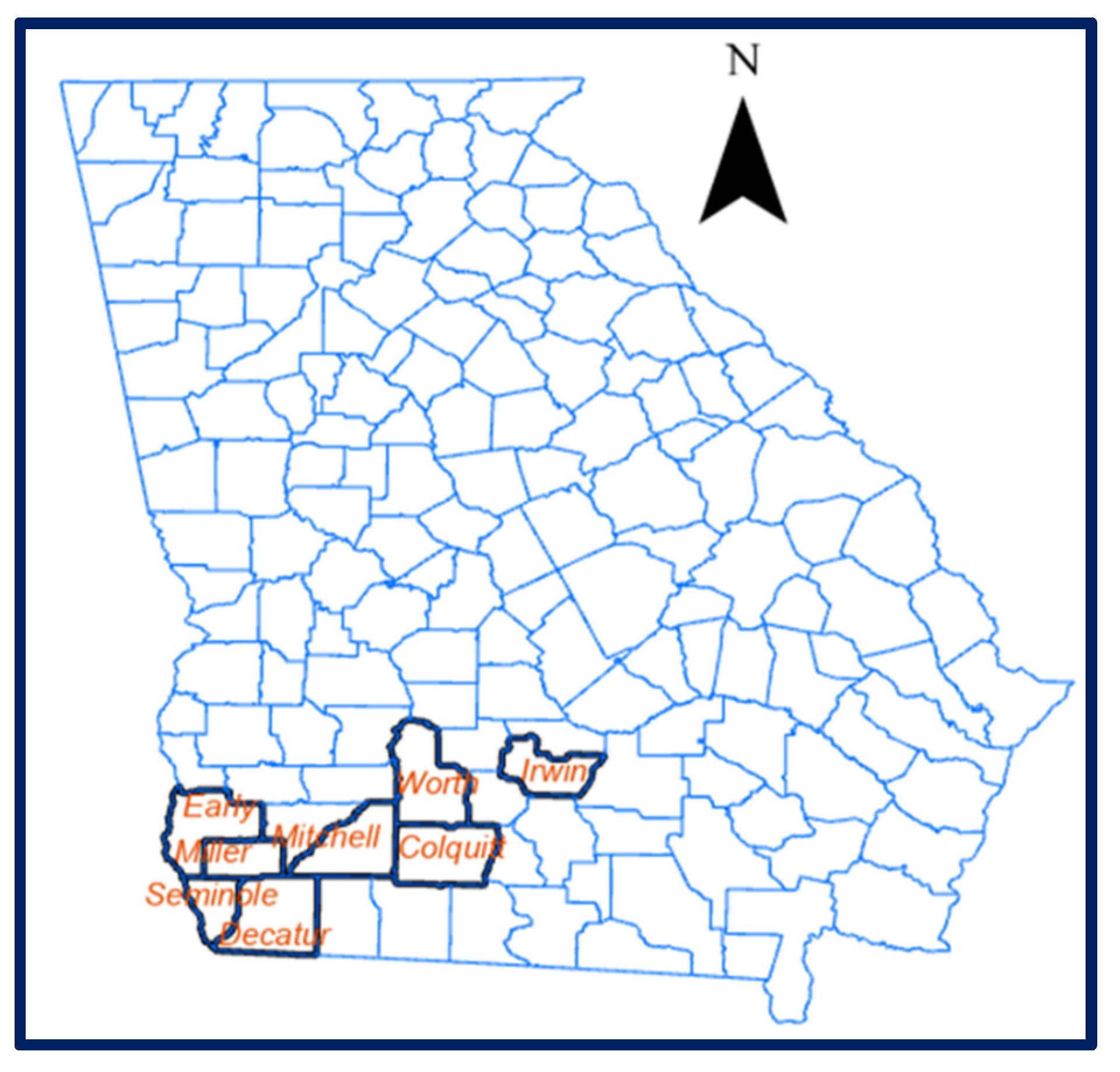


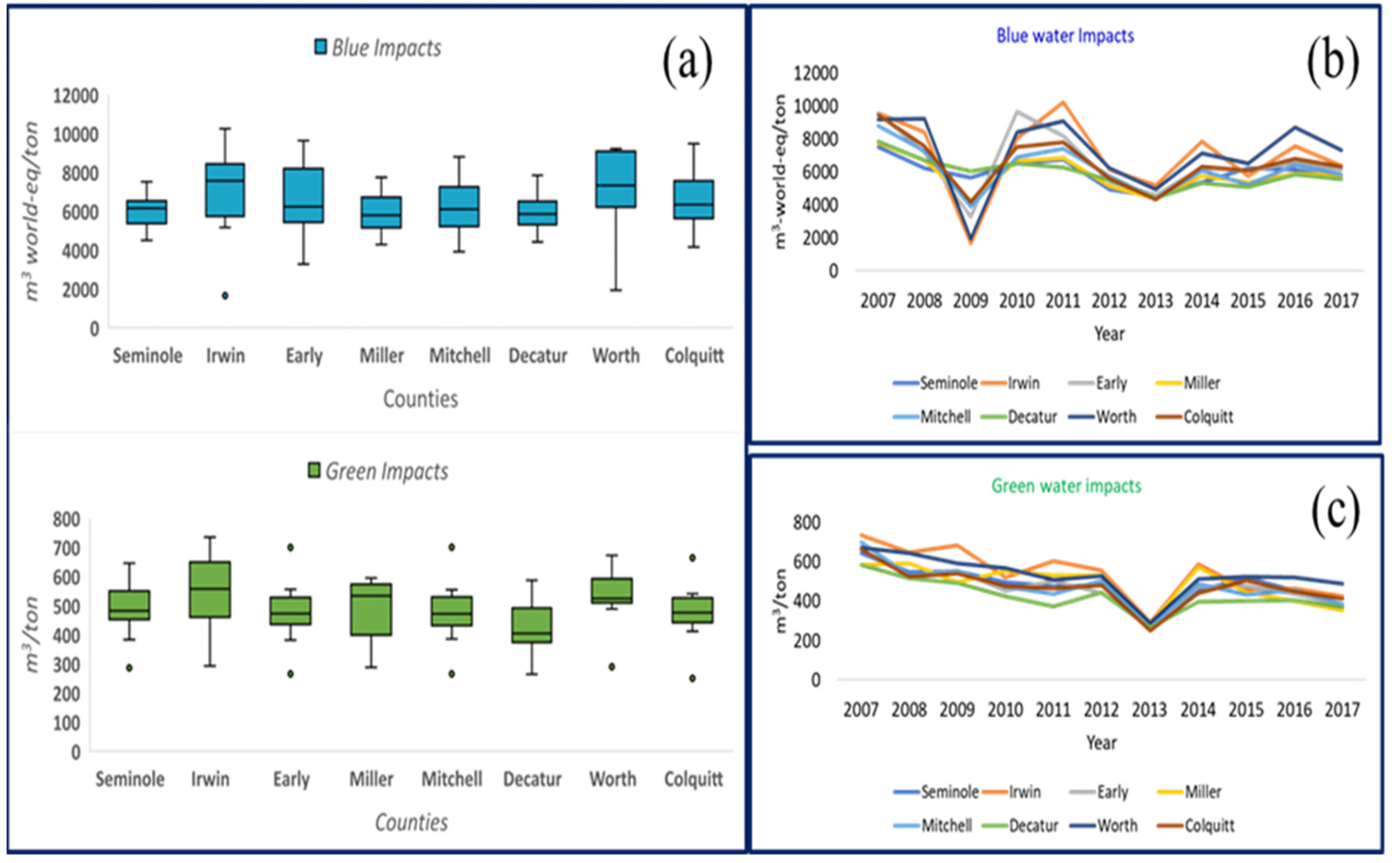
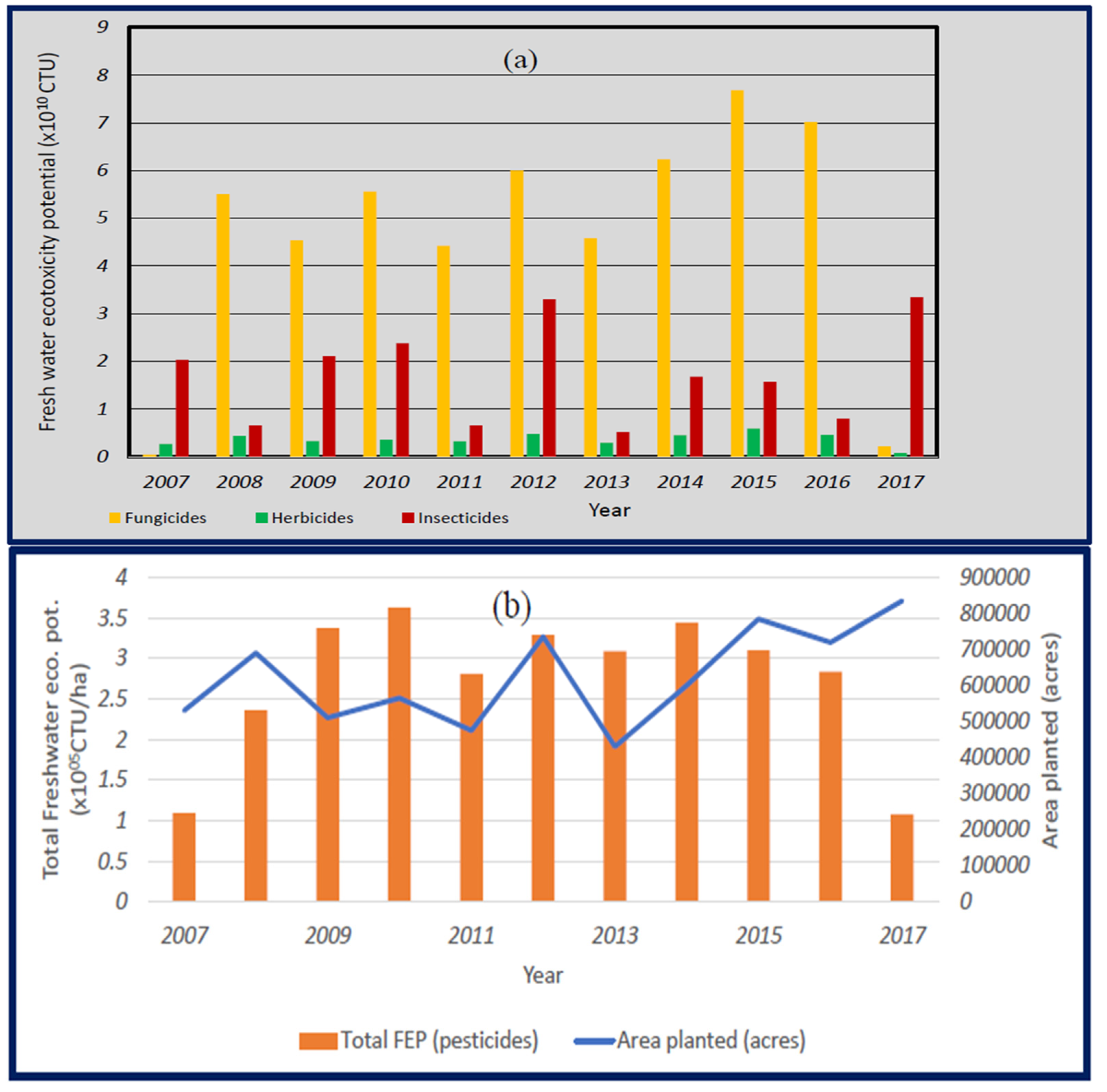
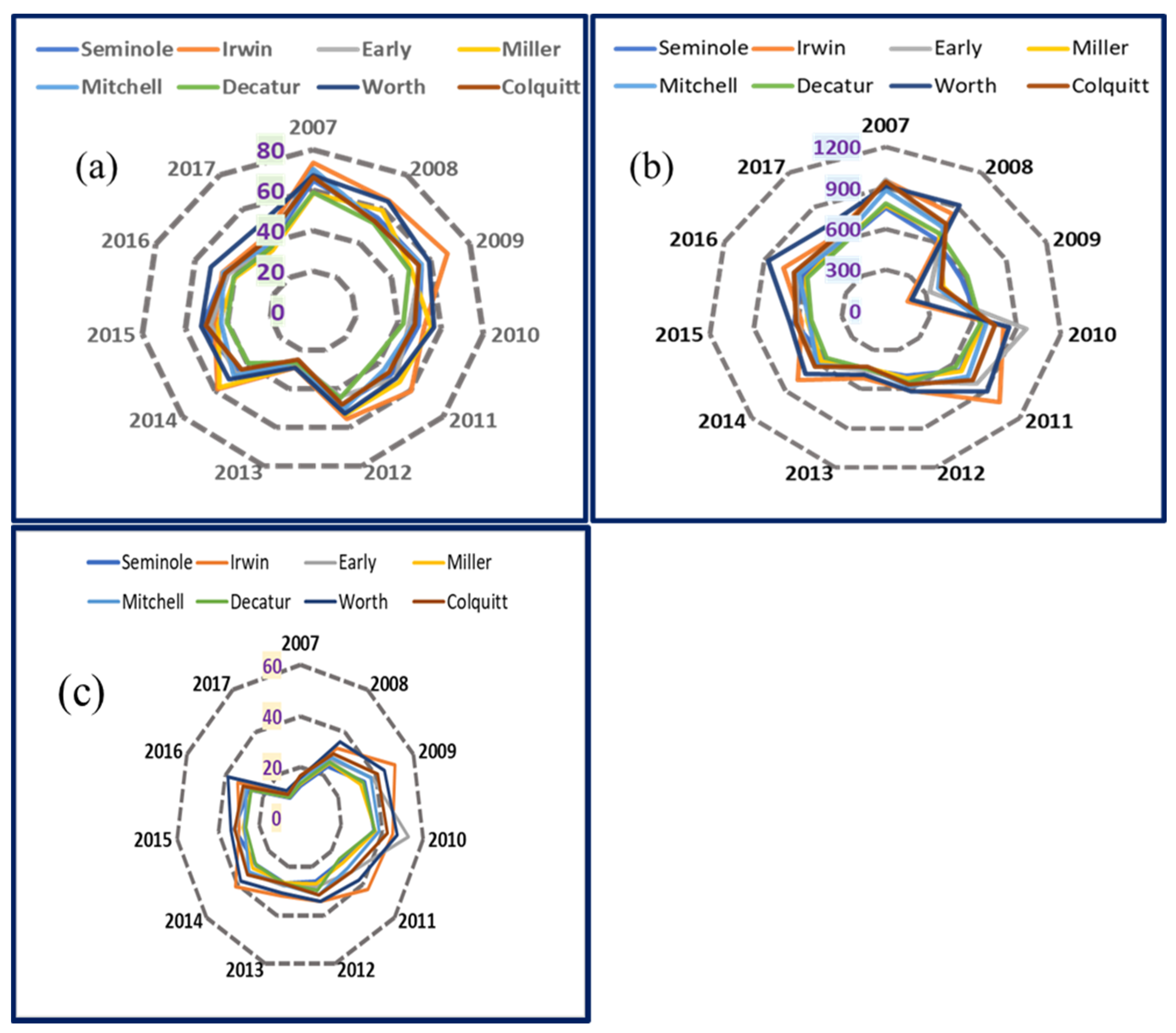

| Pesticide Category | Pesticide (Chemical) | Half-Life (Soil) | Half-Life (Water) | Sorption (Koc) mL/g | Water Partition Coefficient (Kow) | Water Solubility |
|---|---|---|---|---|---|---|
| Fungicides | Chlorothalonil | 5–15 days | Hours to 2 weeks | 3.6 | 2.94 | 810 microg/L |
| Flutolanil | 284 days | 8–11 days | 2.7–3.2 | 2.8–4.7 | 8 mg/L | |
| Fludioxonil | 164 days | 51–154 days | 2.1–2.7 | 4.1 | 1.8 mg/L | |
| Herbicides | Bentazone | 10–20 days | <24 h | 1.5 | −0.46 | 7712 mg/L |
| Ethalfluralin | 13–14 days | 2 days | 3.5 | 5.1 | 0.01 mg/L | |
| Pendimethalin | 42–1322 days | 2–60 days | 3.8–4.6 | 5.2 | 0.275 mg/L | |
| Insecticides | Chlorpyrifos | 7–120 days | 21–28 days | 4.4–5.8 | 4.7 | 1.4 mg/L |
| Phorate | 2–173 days | 2–60 days | 2–4 | 3.4 | 50 mg/L |
| Estimate | Std. Error | Value | Pr (>|t|) | |
|---|---|---|---|---|
| Intercept | 27.982259 | 63.193737 | 0.443 | 0.659135 |
| bluewfp | −0.045753 | 0.013561 | −3.374 | 0.001157 ** |
| greenwfp | −0.020049 | 0.014920 | −1.344 | 0.182904 |
| grdd | −0.031310 | 0.009843 | −3.181 | 0.002108 ** |
| moist | 0.011627 | 0.006301 | 1.845 | 0.068797 * |
| yld | −11.943715 | 3.040539 | −3.928 | 0.000184 *** |
| precip | −0.0524720 | 0.014912 | −3.519 | 0.000727 *** |
| tminl | 3.022110 | 1.668138 | 1.812 | 0.073887 * |
| pdsil | 0.234127 | 0.727269 | 0.332 | 0.748370 |
| tmaxl | 3.389985 | 0.883950 | 3.835 | 0.000253 *** |
Publisher’s Note: MDPI stays neutral with regard to jurisdictional claims in published maps and institutional affiliations. |
© 2022 by the authors. Licensee MDPI, Basel, Switzerland. This article is an open access article distributed under the terms and conditions of the Creative Commons Attribution (CC BY) license (https://creativecommons.org/licenses/by/4.0/).
Share and Cite
Deepa, R.; Anandhi, A.; Bailey, N.O.; Grace, J.M., III; Betiku, O.C.; Muchovej, J.J. Potential Environmental Impacts of Peanut Using Water Footprint Assessment: A Case Study in Georgia. Agronomy 2022, 12, 930. https://doi.org/10.3390/agronomy12040930
Deepa R, Anandhi A, Bailey NO, Grace JM III, Betiku OC, Muchovej JJ. Potential Environmental Impacts of Peanut Using Water Footprint Assessment: A Case Study in Georgia. Agronomy. 2022; 12(4):930. https://doi.org/10.3390/agronomy12040930
Chicago/Turabian StyleDeepa, Raveendranpillai, Aavudai Anandhi, Nathaniel O. Bailey, Johnny M. Grace, III, Omolola C. Betiku, and James J. Muchovej. 2022. "Potential Environmental Impacts of Peanut Using Water Footprint Assessment: A Case Study in Georgia" Agronomy 12, no. 4: 930. https://doi.org/10.3390/agronomy12040930
APA StyleDeepa, R., Anandhi, A., Bailey, N. O., Grace, J. M., III, Betiku, O. C., & Muchovej, J. J. (2022). Potential Environmental Impacts of Peanut Using Water Footprint Assessment: A Case Study in Georgia. Agronomy, 12(4), 930. https://doi.org/10.3390/agronomy12040930






